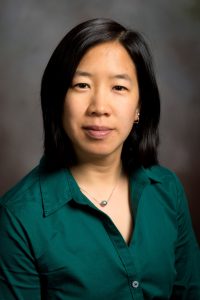Environmental engineering for the 21st century: addressing grand challenges
Under the banner of the National Academies of Sciences, Engineering and Medicine, a committee of 18 prominent environmental engineers, scientists and policy experts were tasked with identifying the most pressing environmental engineering challenges of the 21st century. Linsey Marr, Professor of Civil and Environmental Engineering at Virginia Tech in the US, tells us about this ambitious and forward-thinking report
“As humanity faces mounting and diverse challenges, the field of environmental engineering must build on its unique strengths…”
A strong statement that accepts the undeniable issues facing today’s engineers and lays down the gauntlet for their future success. As Linsey explains, “Environmental engineers are unique in applying a broad range of natural sciences—physics, chemistry, biology, and mathematics—to solve practical problems. They are trained to help assess various options and weigh trade-offs, such as risks, benefits, and costs.”
The NAS’ report states that, “solving global challenges cannot be done by environmental engineers alone”. While some people may believe that science will solve these challenges, and that the general public does not need to play its part or change its habits, Linsey believes that many different stakeholders have roles to play.
“Environmental engineers can propose technical solutions, but we need the help of policymakers to put these solutions into action, and the ‘buy-in’ of the public to support them. In developing technical solutions to a problem, we also need to think about providing people with greater convenience and new opportunities to improve their quality of life. People need tangible reasons for altering their habits, besides the abstract motivation of ‘saving the planet’.”
The report accepts that with topics such as climate, air pollution and energy sparsely covered in current US university environmental engineering programmes, there are barriers to overcome. In addition, what a student covers in the US may not be the same as what a student in another part of the world focuses on – and vice versa.
Linsey explains, “Many environmental engineering programmes [in the US] have a primary focus on water resources and water quality. This is probably because awareness of problems associated with water, and the science and engineering surrounding them, emerged earlier than our awareness about climate, air pollution and energy did. The US has been very successful in improving its air quality, so students here generally have less awareness about air pollution than students from places in India and China, where air pollution is unavoidable in most major cities.”
No matter where they might be in the world, however, Linsey is clear about the impact young environmental engineers will have.
A strong statement that accepts the undeniable issues facing today’s engineers and lays down the gauntlet for their future success. As Linsey explains, “Environmental engineers are unique in applying a broad range of natural sciences—physics, chemistry, biology, and mathematics—to solve practical problems. They are trained to help assess various options and weigh trade-offs, such as risks, benefits, and costs.”
The NAS’ report states that, “solving global challenges cannot be done by environmental engineers alone”. While some people may believe that science will solve these challenges, and that the general public does not need to play its part or change its habits, Linsey believes that many different stakeholders have roles to play.
“Environmental engineers can propose technical solutions, but we need the help of policymakers to put these solutions into action, and the ‘buy-in’ of the public to support them. In developing technical solutions to a problem, we also need to think about providing people with greater convenience and new opportunities to
improve their quality of life. People need tangible reasons for altering their habits, besides the abstract motivation of ‘saving the planet’.”
The report accepts that with topics such as climate, air pollution and energy sparsely covered in current US university environmental engineering programmes, there are barriers to overcome. In addition, what a student covers in the US may not be the same as what a student in another part of the world focuses on – and vice versa.
Linsey explains, “Many environmental engineering programmes [in the US] have a primary focus on water resources and water quality. This is probably because awareness of problems associated with water, and the
science and engineering surrounding them, emerged earlier than our awareness about climate, air pollution and energy did. The US has been very successful in improving its air quality, so students here generally have less awareness about air pollution than students from places in India and China, where air pollution is unavoidable in most major cities.”
No matter where they might be in the world, however, Linsey is clear about the impact young environmental engineers will have.
 ABOUT LINSEY
ABOUT LINSEY
Linsey loved maths and science when she was a kid and studied engineering at Harvard University. When out running for exercise, Linsey often worried about the health effects of the vehicle exhaust fumes she was breathing in and so decided to focus on air pollution in graduate school. She chose to become a professor because she loves discovering new knowledge and sharing it with others.
PUTTING THE REPORT INTO ACTION
“This report was inspired, in part, by the National Academy of Engineering’s Grand Challenges for Engineering, announced in 2008,” says Linsey. “Several universities initiated Grand Challenge Scholars programmes to educate students to take on those challenges and, twelve years later, we need to build on these. With this report, we are hoping to spur universities on to expand programmes for environmental engineering. Though we’re aiming for a big impact at university level, we’re also making the report accessible to middle school and high school students. Our goal is to raise awareness of environmental engineering and the wealth of opportunities it holds.”
Read the report: Environmental Engineering for the 21st Century: Addressing Grand Challenges: https://www.nap.edu/catalog/25121/environmentalengineering-for-the-21stcentury-addressing-grandchallenges
TEACHERS ARE KEY
Linsey believes, “Teachers have an opportunity to engage students, to help them to understand the importance and breadth of the challenges and to look ahead to the future. By providing students with strong foundations in science and math, along with an appreciation for social sciences, teachers can help train students to solve these grand challenges as they move forward in their educations and careers.
“We’ve developed an online toolkit (designthefuturetoolkit.com) designed to help students develop their own solutions to the challenges presented in our report. The toolkit offers teachers and students resources to help them work through two discovery-based learning projects: one to design a city of the future and the other to create a public campaign about the environmental impact of smartphones. Students are encouraged to use information from the report and to explore its more than 300 primary references. The projects are aimed at high school students and also offer some support for presenting the materials to middle school students.”



